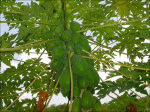 |
 |
|
APPLICATIONS AND DOSAGE. CARICA PAPAYA - PAPAYA. (100 % carica papaya leaves) |
| Papaya tincture:
Overview: Carica papaya contains the enzyme papain, present in the fruit, stem and leaves. Meat can be tenderized by wrapping it in a papaya leaf before cooking. It contains biologically active compounds such as chymopapain and papain, which are aids in digestion. Enzymes accelerate reactions within body cells.  In the human body, the pancreas produces enzymes that break down foods into nutrients Individuals who have cystic fibrosis or diseases of the pancreas may not produce enough natural enzymes to digest foods properly.
In the human body, the pancreas produces enzymes that break down foods into nutrients Individuals who have cystic fibrosis or diseases of the pancreas may not produce enough natural enzymes to digest foods properly.Papain is proteolytic, meaning that it digests proteins. Frequently it is included in prescription combinations of digestive enzymes to replace what individuals with cystic fibrosis or pancreas conditions cannot produce these naturally. Because it improves digestion in general, papain has also been used orally to treat less serious digestion disorders (bloating and chronic indigestion) Papain also is used to treat arthritis and intestinal worms. The softening and disintegrating qualities of papain have been taken advantage of in the treatment of warts, corns, sinuses and chronic forms of scaly eczema and other hardness of the skin In studies of cancer patients, oral enzyme supplements containing papain helped to relieve treatment side effects such as mouth sores and difficulty in swallowing. Phyto-chemicals in papain may increase immune system function and may also promote the release of natural chemicals that attack tumor cells. Papain may lessen inflammation, as well. All of these potential effects make preparations containing papain useful as an addition to cancer therapy. An oral prescription product containing papain and other enzymes has orphan drug status in the United States for the treatment of multiple myeloma, a form of bone marrow cancer. An orphan drug has received approval from the U.S. Food and Drug Administration (FDA) because it shows effectiveness for treating severe or rare diseases that usually have few other treatment options. An injectable form of the enzym chymopapain has been used to treat herniated (“slipped”) discs in the spine. Phytochemicals: The green fruit is reported to contain protein, fat, carbohydrate, fiber, ash, Ca, P, Fe, 7 mg Na, K, beta-carotene equivalent, thiamine, riboflavin, niacin, and ascorbic acid. vitamin E. The glycoside, carposide, and the alkaloid, carpaine, pseudo-carpaine, D1-piperideine alkaloids, dehydrocarpaine I and II, water, caoutchouc-like substances, pectinous matter and salts, malic acid, papain, resin. Fatty oil, volatile oil, a glycoside, caricin, and the enzyme, myrosin. saturated acids (palmitic, stearic, and arachidic) unsaturated acids (oleic and linoleic). , bactericidal aglycone of glucotropaeolin benzyl isothiocyanate), sinigrin, the enzyme myrosin, and carpasemine. Flath and Forrey (1977) identified 106 volatile components in papaya. Applications: Papaya Leaf has been used as an aid for stomach ailments, due to its enzyme content. Papaya Leaf especially aids in the digestion of proteins, but also helps to digest carbohydrates and fats. Papaya Leaf also shows promise as an aid in combating ulcers Dosage: Tincture: 1 – 4 ml. daily Infusion: 1 - 2 cups daily Caution/side effects: Do not use this product if you are pregnant, nursing, have recently had surgery, currently taking anti-thrombolytic agents, blood thinners or if you have cystic fibrosis. Reference: |